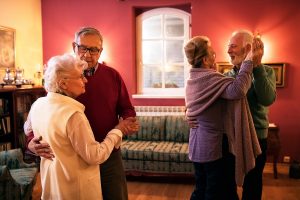 Your treatment of symphysiotomy reveals the practice as not just an instance of bad medicine, but a political and moral problem. Can you describe what you see as the forces that served as the underlying “logic” for the performance of this procedure?
Your treatment of symphysiotomy reveals the practice as not just an instance of bad medicine, but a political and moral problem. Can you describe what you see as the forces that served as the underlying “logic” for the performance of this procedure?
Symphysiotomy was a pro-life operation. C-section, standard in Western medical care at the time, was seen by prominent Irish physicians as unnatural, possibly limiting the number of future births. Symphysiotomy was viewed as natural because it remained vaginal. And as it “widened” the pelvis to prepare a woman for future prolific childbearing, it also ensured a laboring mother experienced the pains of childbirth, in accordance with her Catholic duty. I have witnessed survivors describe the agony of delivering a child through broken bones. [The] pelvis was not merely widened. It was unhinged.
The pro-life motivations behind symphysiotomy suited the social climate in Ireland after independence from England in 1922, which valorized the family unit, and followed the conservative morals of the Catholic Church concerning family life. The new constitution explicitly outlined a woman’s role to be within the home, and legislation made employment after marriage difficult to maintain. Birth control was illegal in Ireland until the 1980s, and abortion is still so, except in cases where the woman is accepted to be suicidal by a medical professional.
Through my research I have come to see the implementation of symphysiotomy in post-independence Ireland as a form of positive eugenics. Post-independence Ireland restored all “fertile grounds” as the exclusive property of Irish men and the Irish state. Controlling women’s bodies was essential to the production of a new Irish identity. After independence, women were expected to emulate “Mother Ireland,” to perpetuate an idealized femininity through marriage and motherhood, and to populate the new nation. In order to achieve these ends, some physicians mutilated and altered the bone structure of hundreds of women.
What role does art play pertaining to symphysiotomy and its survivors?
The on-paper history of this surgery remains unwritten. Most medical records are mysteriously unavailable. By refusing to admit to widespread medical negligence in the most recent ruling, the Irish state refused to acknowledge the memory and testimony of survivors. Erasing them as subjects, the state persists in dehumanizing these women decades after the initial intervention. When individual voices are silenced in this way, we are left with lived violence. This violence resonates on a collective level.
I think art provides a means – if incomplete – of sharing the stories of these survivors, honoring their subjectivity and restoring their lived experience to Irish history. Art can perhaps provide a route to understanding, recognition, and action outside the legal justice system, which has so far neglected its duty to these women.
What about the role of art in addressing trauma and pain more broadly?
On a larger scale, art works to create meaning and involves the act of witnessing. Witnessing requires participation and so calls on our empathy. It becomes more difficult to rationalize or detach when we feel connected personally, emotionally. I choose the body and performance in the hopes of generating new narratives about bodies and pain, to allow for re-interpretation – rather than mere re-living – of traumatic experience. The formation of the collective has been a source of strength and solace for survivors, as trauma and pain wreak havoc when they are experienced in isolation. Often occurring in public space, performance is potentially a way of re-framing harm, and bringing it under many more eyes. It is this empathetic, embodied, and collective understanding in direct relation to human rights abuses and the trauma of others that I hope to foster in my practice.
What do you see your role to be as an artist?
I have to think very carefully about my position in relation to these women and this subject. I wasn’t raised in Ireland, but my grandparents lived here until their twenties, and traveling back was a big part of my childhood. I don’t know what it’s like to have lasting physical disabilities, but I have experienced gender-based medical violence. I know what it is to experience violation and violence at the hands of an inscrutable medical system. I claim my work as feminist, and about a collective trauma, one that violates a dignity present in all of us. I am not a spokesperson for these women, nor do I have the power to heal them. But I want my work to express my solidarity.
Describe what is happening in your performance pieces for “Hold Harmless.”
My first piece for “Hold Harmless” marked the opening of the first SoS case in the High Court this year, and the next acted in solidarity with the second case. Each piece mirrored a session of the court, lasting two hours, and was made in front of the National Maternity Hospital, where many symphysiotomies were performed. On January 29th, I held a crown of thorns between my legs and walked, hindered by this object, up and down in front of the hospital. On February 27th, I hung a broken sink from my neck, like a yoke, and did the same. The porcelain was painted with the testimony of the survivor who lost her case on May 1st: “I thought both sides of my body were on the floor.” The thorns became a tunnel through which I watched my feet. My gait changed to compensate for their presence. The sink was unwieldy, the two halves uneven. It constantly pulled me off balance.
Many survivors were forced to walk immediately after their symphysiotomies, and sent home without post-operative care, including antibiotics and pain management. I must be clear – I have no ability to feel survivors’ pain. I make no attempt to do so, or to conjure their pain in others. I do hope these works will help people realize their connection to these women, and their own potential for silence, speech, or action.
In your work with survivors, what have you found that most survivors want in terms of redress?
Many survivors I work with have expressed their wish for an admittance of wrongdoing and negligence by the state and by medical personnel, and hope justice will provide both explanation and apology. The general sentiment among the women is that, after suffering in stigma and isolation for so long, they are in this fight together. And they want their stories to be told, not only for those still engaged in the campaign, but for the hundreds of women who have died without their experience being acknowledged. Compensation, if it were to arrive, would come after decades of managing severe disability, and can hardly restore what has been lost. But it’s vital that the Irish state provide individualized and appropriate compensation and rehabilitation in each case.
What can people do to show their support for survivors of symphysiotomy, or to contribute to the cause?
Spread the word! Most people are shocked to hear about symphysiotomy, and the injustice still experienced by survivors. Those who are interested can follow and support the campaign, beginning by liking the Survivors of Symphysiotomy’s page on Facebook. They can also donate on the group’s website. Funds may assist, for example, in the retrieval of medical records in order to provide proof of surgery. This is an expensive process for the women, many of whom are living on a pension.
Crucially, any pressure on the Irish government, on a national and international level, helps, and acts in accordance with the conclusions of the UN Human Rights Committee, which, on July 24th, 2014, called on the State party to initiate an independent investigation into the practice, to prosecute and punish the perpetrators, and to provide survivors with an effective remedy.
All images courtesy of Joseph Carr Photography
















